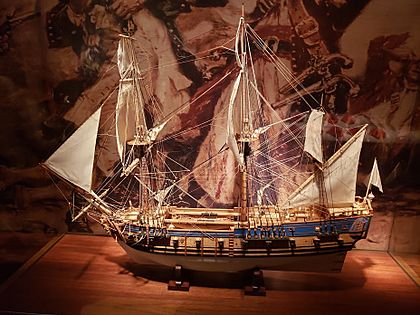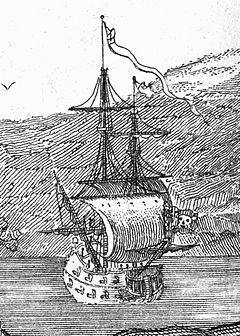Queen Anne's Revenge facts for kids
class="infobox " style="float: right; clear: right; width: 315px; border-spacing: 2px; text-align: left; font-size: 90%;"
| colspan="2" style="text-align: center; font-size: 90%; line-height: 1.5em;" |
|} The Queen Anne's Revenge was a famous ship from the early 1700s. It was the main ship, or flagship, of the well-known pirate Blackbeard, whose real name was Edward Teach.
This ship was likely built around 1710. It was first used for trade in England and called Concord. Later, French privateers (like legal pirates) captured it and renamed it La Concorde. For several years, French sailors used the ship for various purposes, including transporting goods and people. In 1717, Blackbeard captured the ship. He used it for less than a year, but during that time, he captured many other ships.
In May 1718, Blackbeard's ship got stuck in shallow water near what is now Beaufort Inlet, North Carolina, in the United States. After it got stuck, the crew and supplies were moved to smaller ships. In 1996, a company called Intersal Inc. found the remains of a ship. It was later confirmed to be the Queen Anne's Revenge. This shipwreck was then added to the U.S. National Register of Historic Places.
Contents
| History | |
|---|---|
| Name | La Concorde |
| Launched | c. 1710 |
| Captured | Saint Vincent, 28 November 1717 |
| Name | Queen Anne's Revenge |
| Fate | Ran aground on 10 June 1718 near Beaufort Inlet, North Carolina |
| General characteristics | |
| Class and type | Frigate |
| Tons burthen | 200 bm |
| Length | 103 ft (31.4 m) |
| Beam | 24.6 ft (7.5 m) |
| Sail plan | Full-rigged |
| Complement | up to 300 in Blackbeard's service |
| Armament | 40 cannons (alleged), 30 found |
|
Queen Anne's Revenge
|
|
| Lua error in Module:Location_map at line 420: attempt to index field 'wikibase' (a nil value). | |
| Nearest city | Atlantic Beach, North Carolina |
| Area | less than one acre |
| Built | c. 1710 |
| NRHP reference No. | 04000148 |
| Added to NRHP | March 9, 2004 |
The Ship's Journey and Capture
The ship that became the Queen Anne's Revenge was a 200-ton vessel, probably built in 1710. It was used by a French naval officer named René Duguay-Trouin for some time. Later, it became a ship used for transporting goods and people. It was operated by a French trader from Nantes until it was sold in 1713.
The French Navy briefly got the ship back in November 1716. But just five months later, it was sold again in France for trade. On November 28, 1717, Blackbeard and his pirates captured the ship. This happened near the island of Saint Vincent in the West Indies.
Blackbeard's Flagship
After selling its cargo in Martinique, Blackbeard made the vessel his main ship. He added more heavy cannons to it and renamed it Queen Anne's Revenge. The name might have come from the War of the Spanish Succession, also known as Queen Anne's War in America. Blackbeard had served in the Royal Navy during this war. Another idea is that he named it to show support for the Jacobite cause, as Queen Anne was the last ruler from the House of Stuart.
Blackbeard sailed this ship from the west coast of Africa to the Caribbean. Along the way, he attacked British, Dutch, and Portuguese merchant ships.
The Ship Gets Stuck
In May 1718, Blackbeard blocked the harbor of Charleston. He refused the Governor's offer of a royal pardon. Soon after, on June 10, 1718, Queen Anne's Revenge ran aground while entering Beaufort Inlet, North Carolina.
A former captain named David Herriot said that Blackbeard's ship got stuck off the bar of Topsail Inlet. He also said that another ship, the Adventure, also got stuck nearby while trying to help. Blackbeard then broke up his group of ships. He moved supplies to the smaller Adventure and escaped. He left some crew members on a small island, but Captain Stede Bonnet later rescued them. Some people think Blackbeard purposely got the ship stuck to get rid of some of his crew.
Soon after, Blackbeard gave up piracy for a short time. He accepted the King's Pardon for himself and his remaining crew from Governor Charles Eden. However, Blackbeard returned to piracy later that year and was killed in a fight in November 1718.
Finding and Exploring the Shipwreck

A private research company, Intersal Inc., found the shipwreck believed to be Queen Anne’s Revenge on November 21, 1996. Mike Daniel, the company's director of operations, found it using historical research. The shipwreck is in 28 feet (8.5 meters) of water. It's about one mile (1.6 kilometers) offshore of Fort Macon State Park in Atlantic Beach, North Carolina.
On March 3, 1997, the governor of North Carolina, James B. Hunt, announced the discovery. He said the state would protect the site and help people see the amazing items found there.
What Was Found?
So far, thirty cannons have been found, and more than 300,000 items have been recovered. The cannons came from different places, like Sweden and England. They were also of different sizes, which is what you would expect from a pirate crew.
In 2000 and 2001, live underwater videos of the project were shown online. This was part of the QAR DiveLive program. It allowed thousands of children worldwide to talk to scientists and learn about underwater archaeology.
In November 2006 and 2007, more items were found and brought to the surface. These new items seemed to confirm that the wreck was indeed Queen Anne's Revenge. For example, the cannons were found loaded. Also, there were more cannons than a ship of this size would normally carry, and they were from different makers. Markings on a recovered part of the ship's back (stern) showed it was built using French measurements.
By the end of 2007, about one-third of the shipwreck had been fully dug up. Part of the ship's bottom, including much of the main beam (keel) and part of the stern post, has survived. The 1,500-pound stern post was recovered in November 2007. The North Carolina Department of Natural and Cultural Resources (NCDNCR) created a website about Queen Anne's Revenge because of the public's great interest.
Items found in 2008 included pieces of ceramic and pewter, lead strainer parts, a nesting weight, a cannon apron, ballast stones, a sword guard, and a coin.
Recent Discoveries
In 2010, goals included moving one of the ship's largest cannons to a special area underwater. They also checked how much the anchors and cannons were rusting. They added special aluminum parts to stop more rust. They also continued digging at the site.
In 2011, a 0.9-ton anchor from the ship was brought to the surface. Many makeshift weapons, like canister shot, were also found.
On August 29, 2011, the National Geographic Society announced that North Carolina had officially confirmed the shipwreck was Queen Anne's Revenge. This changed an earlier conclusion. Specific items that helped confirm this included a brass coin weight with a picture of Queen Anne of England, made during her rule (1702–1714). Also found was a wine glass stem with diamonds and tiny crowns, made to celebrate the 1714 crowning of King George I. The remains of a French hunting sword with a picture resembling King Louis XV were also found.
On June 21, 2013, two more cannons were recovered from the ship. A few months later, on October 28, archaeologists found five more cannons.
The 23rd of 30 cannons found at the site was recovered on October 24, 2014. This gun is about 56 inches (142 cm) long and weighs over 300 pounds (136 kg). It might be similar to a Swedish gun found earlier. Nine cannonballs, bar shot halves, an iron bolt, and a grenado were also found in 2014.
In January 2018, sixteen pieces of paper were found inside a cannon. These scraps were from a book called A Voyage to the South Sea, and Round the World, Perform'd in the Years 1708, 1709, 1710 and 1711 by Captain Edward Cooke. It's likely the pages were torn from the book and used as wadding in the cannon. Some of the items found at the shipwreck are on display at the National Museum of American History. Some have also been loaned to the Musée National de la Marine in Paris.
So far, 24 of the 30 known cannons have been dug up. Six of these cast-iron cannons have marks showing where they were made. One small cannon has an English mark. A larger cannon has an English mark and the mark of Major John Fuller, who made cannons in England. Four smaller cannons have marks from Jesper Eliaeson Ehrencreutz in Sweden. Two of the Swedish cannons also have clear dates from 1713.
National Register of Historic Places
The Queen Anne's Revenge shipwreck was added to the National Register of Historic Places in 2004. Its reference number is 04000148. It is owned by the State of North Carolina and is located south of Beaufort Inlet, N.C. The shipwreck site is known as 31CR314 by the state of North Carolina.
See also
 In Spanish: Venganza de la Reina Ana para niños
In Spanish: Venganza de la Reina Ana para niños
- Robert Lane (pirate), whose ship was also named Queen Anne's Revenge


